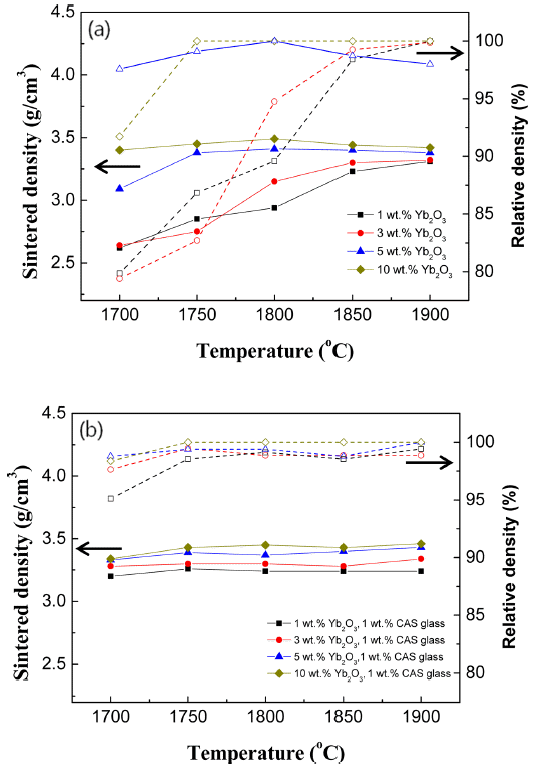Search
- Page Path
- HOME > Search
- [Korean]
- Effect of Morphological Control of Secondary Phase using Yb2O3 and Ca-Al-Si-O-based Glass on Thermal and Mechanical Properties of AlN
- Dong Kyu Choi, Shi Yeon Kim, Dong Hun Yeo, Hyo Soon Shin, Dae Yong Jeong
- J Korean Powder Metall Inst. 2020;27(6):498-502. Published online December 1, 2020
- DOI: https://doi.org/10.4150/KPMI.2020.27.6.498

- 691 View
- 8 Download
-
 Abstract
Abstract
 PDF
PDF We investigate the effects of Yb2O3 and calcium aluminosilicate (CAS) glass as sintering additives on the sintering behavior of AlN. The AlN specimens are sintered at temperatures between 1700°C and 1900°C for 2 h in a nitrogen atmosphere. When the Yb2O3 content is low (within 3 wt.%), an isolated shape of secondary phase is observed at the AlN grain boundary. In contrast, when 3 wt.% Yb2O3 and 1 wt.% CAS glass are added, a continuous secondary phase is formed at the AlN grain boundary. The thermal conductivity decreases when the CAS glass is added, but the sintering density does not decrease. In particular, when 10 wt.% Yb2O3 and 1 wt.% CAS glass are added to AlN, the flexural strength is the highest, at 463 MPa. These results are considered to be influenced by changes in the microstructure of the secondary phase of AlN.
- [Korean]
- Effect of Li2O-Bi2O3 Addition on the Piezoelectric Properties of Pb(Mg1/3Nb2/3)0.65Ti0.35O3 Ceramics
- Jae Hyuk Kim, Shi Yeon Kim, Jeoung Sik Choi, Dong-Hun Yeo, Hyo-Soon Shin, Sahn Nahm
- J Korean Powder Metall Inst. 2019;26(5):405-409. Published online October 1, 2019
- DOI: https://doi.org/10.4150/KPMI.2019.26.5.405

- 613 View
- 1 Download
-
 Abstract
Abstract
 PDF
PDF Piezoelectric ceramic specimens with the Pb(Mg1/3Nb2/3)0.65Ti0.35O3 (PMN-PT) composition are prepared by the solid state reaction method known as the “columbite precursor” method. Moreover, the effects of the Li2O-Bi2O3 additive on the microstructure, crystal structure, and piezoelectric properties of sintered PMN-PT ceramic samples are investigated. The addition of Li2O-Bi2O3 lowers the sintering temperature from 1,200°C to 950°C. Moreover, with the addition of >5 wt.% additive, the crystal structure changes from tetragonal to rhombohedral. Notably, the sample with 3 wt.% additive exhibits excellent piezoelectric properties (d33 = 596 pC/N and Kp = 57%) and a sintered density of 7.92 g/cm3 after sintering at 950°C. In addition, the sample exhibits a curie temperature of 138.6°C at 1 kHz. Finally, the compatibility of the sample with a Cu electrode is examined, because the energy-dispersive X-ray spectroscopy data indicate the absence of interdiffusion between Cu and the ceramic material.
TOP
 KPMI
KPMI

 First
First Prev
Prev


